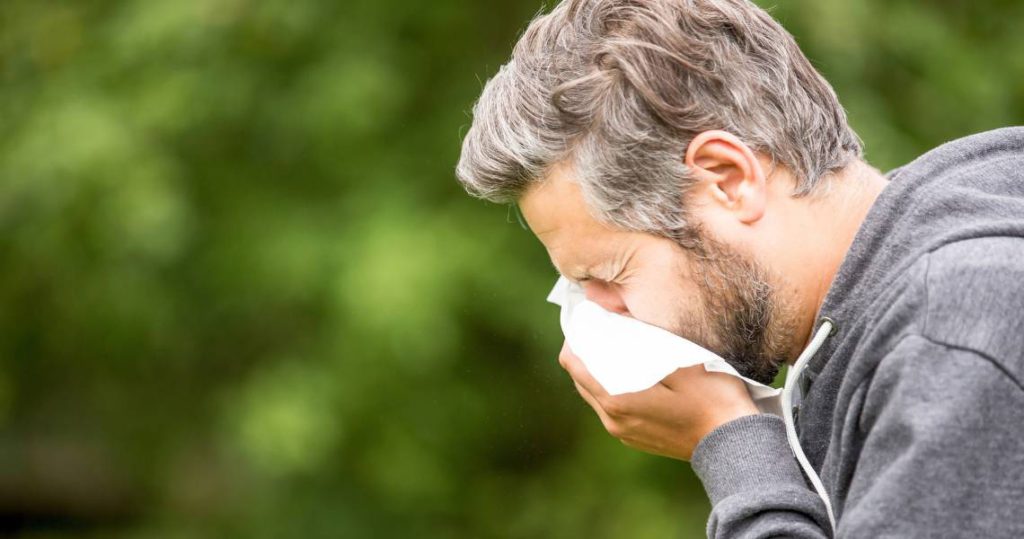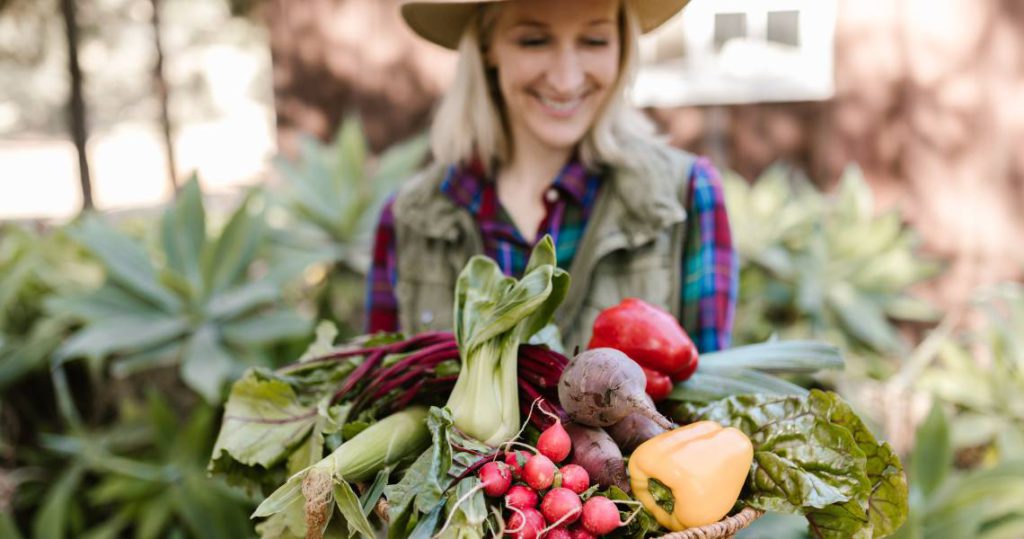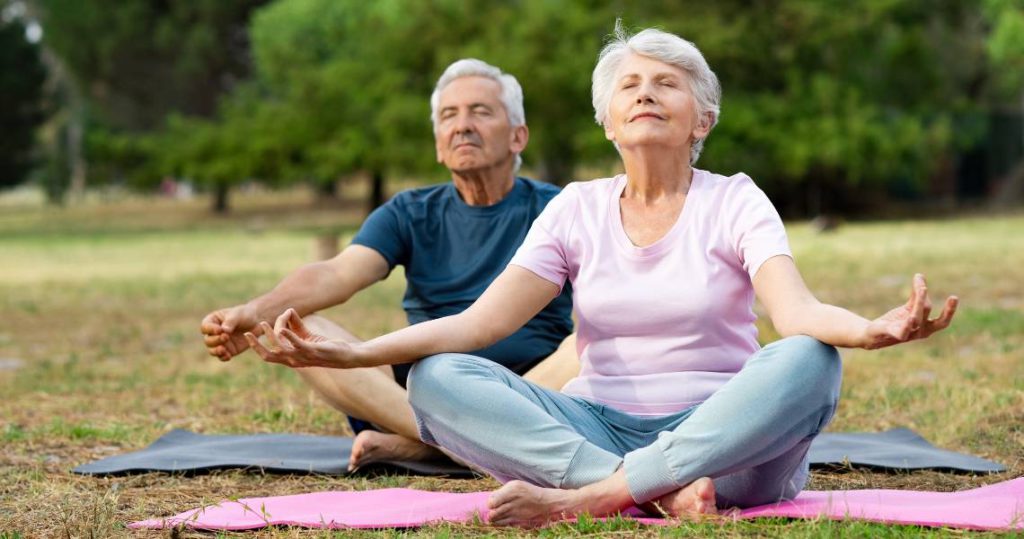
As you prepare for the delightful festivities this Halloween, it’s crucial not to sideline your health, particularly if you’re 50 or older. Securing a flu shot by the end of October is a wise step to shield yourself against the flu, ensuring you enjoy this season to the fullest. However, maintaining your health extends beyond just vaccination.
Integrating regular exercise into your routine is vital. Activities like walking, yoga, or swimming can be gentle on the joints while effectively boosting stamina and strength.
When it comes to diet, focus on nutrient-dense foods that support heart health and bone density, such as leafy greens, lean proteins, and whole grains.
Managing stress is equally important. Techniques such as meditation, deep breathing exercises, or engaging in hobbies you love can significantly mitigate stress levels, enhancing your overall well-being.
For those navigating retirement or managing chronic conditions, understanding your healthcare options is key. Familiarize yourself with Medicare and supplemental plans to ensure you’re fully covered without unnecessary expenses.
Staying connected with community resources can also enrich your social life and provide support where needed. Whether it’s local exercise groups or workshops, these can be great avenues to maintain social ties and keep mentally active.
This Halloween, by focusing on these practical and manageable steps, you can ensure not only a fun season but also a foundation for long-term health and vitality. Your wellness journey is important, and with the right tools and knowledge, you can continue to thrive in your 50s and beyond.
Main Points
- Schedule your flu shot well before Halloween to ensure you’re protected against influenza and its potential complications, a crucial step for maintaining health as we age.
- Embrace the autumn season by participating in gentle outdoor activities such as walking or bird watching in your local park. These activities are excellent for maintaining physical health and mental clarity, crucial for those in their 50s and beyond.
- Opt for healthier Halloween treat options that cater to mature palates and dietary needs, such as dark chocolate, which is rich in antioxidants, or seasonal fruits like apples or pears.
- Integrate stress-reduction techniques into your daily routine, such as mindfulness meditation or tai chi, which are both gentle on the body and effective in managing stress levels during busy times.
- Maintain your social connections by participating in or organizing events within your community that are mindful of safety and accessibility. Consider gatherings that include discussions on topics like retirement planning or health care options, which can be both educational and enjoyable.
These tips are designed to support your overall wellness and enable you to enjoy the festive season healthily and joyfully, resonating with the experiences and needs of those aged 50 and older.
Prioritize Your Flu Shot

As the brisk autumn air settles in, it’s crucial for those of us over 50 to consider getting our flu shots before the end of October. At this stage in life, prioritizing your health is more important than ever, not just for your well-being but also to protect those around you who may be vulnerable.
The flu shot is a key preventative measure that significantly reduces the risk of contracting seasonal influenza, which can be particularly harsh for our age group.
Getting vaccinated isn’t merely about avoiding the flu; research indicates that flu shots can also decrease the risk of experiencing a stroke by up to 12%. This is especially vital for those managing conditions like high cholesterol or blood pressure, providing an additional safeguard against potential health complications.
Staying healthy allows you to enjoy this wonderful phase of life, whether you’re exploring new hobbies, spending time with grandchildren, or traveling.
Today, receiving your flu vaccination is safer and more convenient than ever—even alongside your COVID-19 vaccine, if you haven’t already done so. This dual protection is streamlined to ensure you remain robust and active throughout the flu season. It’s essential to keep yourself free from influenza-related illnesses, making your flu shot a top priority.
For those of us in our 50s and beyond, maintaining an active and healthy lifestyle is crucial. Consider incorporating gentle exercises like yoga, swimming, or walking into your routine. Eating a balanced diet rich in fruits, vegetables, and lean proteins can also play a significant role in supporting your immune system.
And don’t forget to stay informed about healthcare options available to you, including Medicare and supplemental plans, which can provide peace of mind in managing any health issues that arise.
Remember, your health is your wealth, especially at this stage of life. By getting your flu shot and taking proactive steps towards maintaining your health, you’re setting the stage for years of active, fulfilling living.
Stay informed, stay active, and stay connected with your community and loved ones to make the most of these enriching years.
Maintain Regular Exercise

As the leaves begin to show their vibrant colors and the air turns refreshingly crisp, autumn offers a wonderful opportunity for those aged 50 and older to enjoy outdoor exercises that combine the beauty of nature with physical wellness. Engaging in activities like leisurely hikes on gentle trails or establishing a moderate jogging routine can significantly enhance your mood and strengthen your immune system. These activities aren’t only enjoyable but also crucial for maintaining cardiovascular health and joint mobility as we age.
If you find that the weather is less than inviting, there’s no need to pause your physical activity. There are numerous indoor exercises tailored to your needs and capabilities that can keep you moving. From water aerobics in your local pool to yoga classes designed for seniors, these options ensure that you can stay active regardless of the weather.
For those managing chronic conditions or who might be concerned about injury, low-impact exercises such as swimming, cycling on a stationary bike, or light strength training can be particularly beneficial. These activities help maintain muscle mass, improve endurance, and promote flexibility without putting too much strain on the body.
Moreover, staying active isn’t just about physical health; it’s also about mental well-being. Regular exercise helps combat stress, anxiety, and depression, which can be particularly poignant during this stage of life. Engaging with community sports groups or walking clubs can also provide social interaction, which is vital for emotional health as we age.
Remember, it’s important to consult with a healthcare provider before starting any new exercise regimen, especially if you have existing health conditions. They can offer guidance tailored to your specific health needs and help you make the most of these golden years.
Outdoor Activity Benefits
Engaging in regular outdoor activities during the fall season offers numerous benefits, especially for those aged 50 and older. This period of cooler temperatures is ideal for enhancing your physical wellness without the discomfort of overheating, allowing for prolonged exercise sessions amidst the stunning fall foliage. Activities such as walking, gentle hiking, or leisurely biking can be excellent ways to maintain fitness, improve cardiovascular health, and manage weight, which are crucial aspects of health maintenance at this stage of life.
The mental well-being benefits of being outdoors during autumn are equally significant. The serene beauty of the natural landscape, with its array of vibrant colors, provides a peaceful backdrop that can help reduce stress and uplift spirits, counteracting the common mood dips that come with shorter, darker days. Whether it’s a quiet stroll in a nearby park or a light trek on a forest trail, connecting with nature can also boost mindfulness and appreciation for the present moment—qualities that gain even greater importance as we age.
For those in their 50s and beyond, integrating outdoor activities into daily routines can also be a fulfilling way to enjoy leisure time, either solo or socially. Participating in group activities such as bird watching, photography walks, or community gardening can offer both social interaction and physical benefits, enhancing feelings of community and belonging.
Here are a few practical tips to make the most of outdoor activities safely and enjoyably:
- Dress in layers to comfortably adjust to changing temperatures and ensure protection from the elements.
- Choose well-maintained paths or trails that match your fitness level to prevent injuries and make the activity more enjoyable.
- Stay hydrated and carry a water bottle with you, even in cooler weather, to support overall health.
- Consider using walking poles to aid balance and reduce strain on joints, which can be particularly helpful for those with arthritis or mobility issues.
Incorporating these activities into your lifestyle not only fosters physical health but also contributes to a more joyful and vibrant life phase. Embracing the outdoors during the fall can be a wonderful way to celebrate the season and your well-being, making every moment count.
Exercise Routine Ideas
As the weather becomes brisker, it’s important to adapt your exercise routine to accommodate the colder months, especially to maintain your health and wellness as you age. Indoor workouts aren’t only convenient but also offer a variety of activities that can be tailored to your fitness level and health needs, ensuring you continue your physical activity regularly.
Discover the range of fitness classes offered at local gyms or community centers that are suited to those over 50. These might include low-impact options such as water aerobics, gentle yoga, or Tai Chi, which are easier on the joints and beneficial for maintaining flexibility, balance, and strength. Participating in these classes can also offer social opportunities, a key component in staying mentally and emotionally healthy.
Maintaining a consistent exercise schedule is crucial. Aim to integrate these indoor activities into your weekly routine. This regularity helps you keep active and can be adjusted according to your personal health and mobility levels. Regular physical activity is essential for managing age-related changes in the body and can help improve everything from cardiovascular health to bone density.
When planning your fitness activities, consider your current health conditions and consult with healthcare professionals to tailor a routine that best suits your needs. For instance, those with arthritis might benefit from swimming sessions which are soothing on the joints and offer a good cardiovascular workout.
Remember, staying active isn’t just about physical health; it’s also about enriching your lifestyle and enjoying your years of retirement. Engage in activities that bring joy and vitality to your life, whether that’s through group classes, solo exercises at home, or simply incorporating more movement into your daily routine.
The goal is to feel respected, informed, and motivated to continue leading a vibrant and active life. With thoughtful planning and a commitment to staying active, you can enjoy robust health and a fulfilling lifestyle well into your 50s and beyond.
Indoor Workout Options
Maintaining an active lifestyle is crucial throughout our lives but becomes even more significant as we move into our 50s and beyond. As the colder months draw near, transitioning from outdoor activities to indoor workouts can help you stay fit, support your mental health, and keep you connected with a community of like-minded individuals.
Here are three tailored ways to enrich your indoor exercise routine that are particularly beneficial for those aged 50 and older:
- Diversify Your Fitness Routine with Age-Appropriate Classes: Engaging in activities like yoga, tai chi, or water aerobics can be especially beneficial as these classes focus on improving flexibility, balance, and strength, which are crucial for maintaining mobility and preventing falls. Many community centers and gyms offer classes tailored to older adults, providing a great opportunity to meet peers and receive encouragement from instructors who understand your unique needs.
- Create a Comfortable Home Workout Space: Setting up a small gym area at home can provide the convenience and comfort you might prefer. Equip your space with items like light weights, a sturdy chair for seated exercises, and a non-slip yoga mat. Consider incorporating resistance bands, which are excellent for muscle strength and joint flexibility. Additionally, there are numerous online platforms offering guided workouts designed for older adults that you can follow from the safety and comfort of your home.
- Utilize Local Gym or Fitness Center Resources: Many fitness centers offer senior discounts and have trainers knowledgeable in guiding older adults. These facilities often provide a range of equipment tailored to gentler fitness programs and host special classes that cater to your physical capabilities. Being part of such a community can also help keep you motivated and socially active.
Staying active during the fall and winter not only boosts your physical health but also enhances your overall well-being. Indoor workout options are a practical and enjoyable way to continue your fitness journey through the seasons, tailored to meet the needs and challenges of those aged 50 and older. By integrating these activities into your routine, you can enjoy a fulfilling and healthy lifestyle that energizes both your body and mind.
Monitor Seasonal Allergies

Monitoring seasonal allergies is crucial, especially in the fall, when elements like ragweed pollen and mold spores become more prevalent. For those over 50, managing these allergies is key to maintaining your health and enjoying your activities without discomfort.
Understanding the impact of these allergens and taking preventive measures can significantly improve your daily life. Here are some tailored strategies to help you stay ahead of allergy symptoms:
- Install an Air Purifier: Use a high-quality air purifier in your home to help filter out allergens. This is particularly effective in maintaining a clean indoor environment, which is crucial as we spend more time indoors during cooler months.
- Keep Windows Closed on High Pollen Days: To prevent allergens from entering your home, it’s advisable to keep windows closed during days when the pollen count is high. This simple step can reduce your exposure to allergens significantly.
- Cleanse After Outdoors: After enjoying time outside, whether gardening, walking, or engaging in other leisure activities, make a habit of showering and changing into clean clothes to remove any pollen that may have adhered to your skin or clothing.
Common symptoms to watch for include sneezing, runny nose, itchy eyes, and congestion. Early recognition of these symptoms allows for prompt and effective management. Over-the-counter medications often provide relief, but for those seeking more tailored strategies, consulting with an allergist can be invaluable.
An allergist can provide personalized advice and treatment options that are specifically suited to your needs and health profile. Additionally, as we age, it’s important to stay informed about how our bodies react to different environments and treatments. Engaging with healthcare providers to understand the specifics of allergy management as you age can make a significant difference in your quality of life.
This approach not only helps manage your allergies effectively but also ensures that you can continue enjoying your retirement and leisure activities without being sidelined by allergy symptoms. Remember, taking proactive steps towards managing your health allows you to fully embrace and enjoy your later years with vitality and joy.
Embrace Seasonal Produce

Embracing seasonal produce such as pumpkins, apples, and squash can greatly benefit your health, especially as you navigate the changes that come with age. These foods aren’t only packed with essential vitamins and antioxidants but also bolster your immune system during the cooler months—a crucial factor for those in their 50s and beyond, when maintaining robust health becomes a priority.
Fall is the perfect season to enrich your diet with a variety of colorful, nutrient-dense foods. For instance, incorporating vegetables like Brussels sprouts, kale, and sweet potatoes into your meals not only adds delightful flavors but also provides substantial health benefits. Brussels sprouts and kale are rich in vitamins K and C, which are vital for bone health and immune function—key concerns for older adults. Sweet potatoes are an excellent source of vitamin A, essential for preserving vision and immune health.
To optimize the benefits of the fall harvest, consider these practical tips:
- Roast your vegetables: This cooking method enhances the natural sweetness of fall vegetables like beets and carrots, making them a delicious part of your diet.
- Combine varieties: Mixing different seasonal vegetables in your dishes ensures a broader intake of nutrients, supporting overall well-being.
- Preserve surplus produce: If you find yourself with more fruits and vegetables than you can use, consider preserving them through canning or freezing. This way, you can enjoy the health benefits of fall produce all year round.
Eating seasonally not only helps you maintain good health but also supports local farmers and reduces the environmental impact of long-distance food transportation. This fall, let the abundance of the harvest inspire your meals, enhancing both your health and the health of your community.
Limit Sugar Intake

Limiting your sugar intake is particularly important as you journey further into your 50s and beyond. Post-Halloween, the temptation to indulge in leftover candy can be strong, but moderation is key to maintaining your health and energy levels. As we age, our bodies may not handle sugar as efficiently, potentially exacerbating health issues such as diabetes, heart disease, and unwanted weight gain.
In the spirit of enjoying the festivities without compromising your health, consider opting for healthier treats that satisfy the sweet tooth while providing nutritional benefits. Dark chocolate is an excellent choice, rich in antioxidants that support heart health and reduce inflammation, which is crucial for maintaining mobility and comfort in later years.
Furthermore, high sugar consumption can trigger inflammation, a common concern in older adults as it affects overall well-being and can contribute to chronic health issues. By choosing your treats wisely and controlling your sugar intake, you’ll not only keep inflammation at bay but also stay more energized and focused.
Be vigilant about hidden sugars in everyday foods and beverages, such as flavored yogurts, cereals, and soft drinks. Many of these items can sneak extra sugars into your diet without you noticing. Start by carefully reading labels to ensure that you’re not unintentionally consuming more sugar than your body needs. This careful approach will help you maintain a balanced diet, supporting both your immune system and overall health.
As you enjoy this season and move into the colder months, remember that maintaining a healthy lifestyle includes making informed choices about what you eat. Embrace the joys of the season responsibly, and your body will thank you for it.
Stay Hydrated

As the cooler weather sets in, maintaining adequate hydration becomes crucial, particularly for those of us over 50. Hydration isn’t merely about quenching thirst; it plays a fundamental role in supporting overall health and ensuring our skin remains supple and free from the discomfort of dryness during the fall months.
In our busy lives, especially when many of us are taking care of grandchildren or managing various daily tasks, it’s easy to neglect our own hydration needs. However, ensuring we drink enough water is essential for feeling and performing our best.
Proper hydration aids in keeping the skin hydrated, preventing the painful effects of dry, cracked skin—a common concern as we age. Here are some practical tips tailored for those in their 50s and beyond, to help maintain optimal hydration:
- Set Reminders: Utilize tools like alarms on your smartphone or sticky notes placed around your home to remind you to hydrate. It’s a straightforward tactic to keep your water intake regular.
- Keep a Water Bottle Handy: Always have a water bottle close by, particularly when you’re out running errands or enjoying activities outside the home. This habit ensures you can easily hydrate throughout the day without much effort.
- Opt for Hydrating Foods: Include fruits and vegetables such as cucumbers, oranges, and apples in your meals. These foods aren’t only nutritious but also help increase your overall fluid intake.
Drinking sufficient water is also crucial for preventing health complications that become more prevalent as we age, such as urinary tract infections and kidney stones. Moreover, staying well-hydrated contributes to maintaining alertness and energy levels, empowering you to care for others and enjoy your activities to the fullest.
As we focus on caring for our loved ones and embracing the joys of this season of life, let’s not forget the importance of caring for ourselves. Keeping well-hydrated is essential for our well-being, just as much as it’s for those we cherish.
Practice Hand Hygiene

As the autumn season approaches, maintaining your health becomes even more crucial, especially for those of us in our 50s and beyond. Choosing the right type of soap and mastering effective handwashing techniques are simple yet powerful ways to protect yourself from illnesses.
It’s important to wash your hands thoroughly, scrubbing for at least 20 seconds. Select a soap that’s gentle on aging skin, which can be more prone to dryness and irritation.
Remember, handwashing is a first line of defense in preventing the spread of germs. However, when soap and water aren’t readily available, an alcohol-based hand sanitizer can serve as an excellent alternative. Keeping a small bottle in your purse or car can be a practical way to ensure you’re always prepared.
For those of us managing conditions like arthritis, using a soap dispenser with a pump can be easier on the hands. Also, consider soaps with added moisturizers or those labeled as hypoallergenic to avoid any skin discomfort.
Staying vigilant about hygiene plays a significant role in your overall health strategy, which should also include regular physical activity and a balanced diet. Engaging in gentle exercise, like walking or yoga, and eating nutrient-rich foods can help boost your immune system and keep you feeling your best.
This season, take the time to care for your health with these simple, effective practices. Not only will you protect yourself, but you’ll also be safeguarding the health of those around you, sharing more joyful and healthy moments with friends and family.
Choose Right Soap Type
Choosing the Right Soap for Optimal Health After 50
As we age, maintaining robust health becomes increasingly crucial, and one of the simplest yet most effective ways to protect ourselves is through proper hand hygiene. Selecting the right soap, especially for those in their 50s and beyond, can play a significant role in preventing infections and promoting long-term well-being.
Here’s why it’s important to choose the right soap, focusing on your specific needs at this stage of life:
- Infection Control: While the idea of soap with high alcohol content might seem appealing for its germ-killing abilities, it’s essential to consider that mature skin can be more prone to dryness. Opt for soaps labeled as moisturizing or those designed for sensitive skin, which can clean effectively without stripping natural oils.
- Gentle and Safe Formulas: If you have sensitive skin, which is common among older adults, look for hypoallergenic soaps that are free from harsh chemicals and fragrances. These soaps can provide a thorough clean while being gentle on the skin, reducing the risk of irritation.
- Supporting Long-term Health: Regular use of the appropriate soap not only helps in reducing the spread of common colds and other respiratory infections but also supports your overall hygiene. This is particularly important as a strong immune system plays a critical role in your health as you age.
Practical Tips for Choosing Soap:
- Moisturizing Ingredients: Look for soaps that contain natural moisturizers like glycerin or aloe vera.
- Fragrance-Free Options: Choose fragrance-free products to minimize the risk of skin irritation.
- Antibacterial Properties: While not always necessary, consider mild antibacterial soaps if you’re in environments where germ exposure is higher, such as during hospital visits.
By selecting a soap that suits your skin type and health needs, you not only keep yourself safe from germs but also ensure that your skin remains healthy and nourished. Remember, the right products can make a significant difference in your comfort and health outcomes.
Maintaining proper hand hygiene is a simple yet effective way to contribute to your overall wellness journey as you enjoy this vibrant chapter of your life.
Effective Handwashing Techniques
Now that you’ve chosen the right soap, let’s delve into mastering effective handwashing techniques that are especially important as we age. Keeping good hygiene is crucial, not only to prevent the spread of common germs but also to protect against more serious illnesses like the flu and COVID-19, which can be more challenging as our immune systems evolve with age.
Begin by wetting your hands with clean, running water. Then, lather up with a generous amount of soap, making sure to create a rich foam. This step is key to effective cleaning.
Dedicate at least 20 seconds to scrubbing your hands—about the duration it takes to hum the ‘Happy Birthday’ song twice. It’s important to cover all areas: the backs of your hands, between your fingers, and under your nails where germs like to hide. These details matter more as we become more susceptible to diseases.
After scrubbing, rinse your hands well under clean, running water. Dry them thoroughly with a clean towel or let them air dry. Consider using a moisturizing lotion after washing, as older skin can be prone to dryness.
Teaching these steps to grandchildren and emphasizing the routine at critical times, such as before meals and after using the bathroom, not only helps them stay healthy but also reinforces these vital habits in your daily routine.
Importance of Hand Sanitizers
As we age, maintaining robust health becomes increasingly crucial, particularly during the flu season. For those of us over 50, understanding and incorporating effective hand hygiene can play a pivotal role in our overall wellness and ability to enjoy life’s pleasures, from gardening to playing with grandchildren.
Here’s why keeping hand sanitizer handy is especially beneficial for those over 50:
- Immediate Disinfection for Active Lifestyles: For those of us who enjoy spending time outside or traveling, hand sanitizer offers a quick and effective way to kill germs when soap and water aren’t readily available. Whether you’re exploring new hobbies or simply out for a walk, a small bottle of hand sanitizer can ensure that your adventures aren’t halted by illness.
- Portable Protection on the Go: Compact and convenient, hand sanitizers fit easily into a purse, golf bag, or vehicle, making them an ideal companion for daily errands or spontaneous outings. Their portability is particularly useful for those of us who balance various activities and value ease and efficiency in our routines.
- Supports a Healthy Community: Regular use of hand sanitizer can significantly reduce the spread of germs. This isn’t only beneficial for your own health but also helps protect those around you, including peers and family members who may be more vulnerable to infections. By incorporating hand sanitizer into your daily routine, you contribute to the wellness of your community, ensuring that social gatherings and family events remain safe and enjoyable for everyone.
Incorporating hand sanitizer into your daily routine is a simple yet effective step towards maintaining your health and that of your community. By being mindful of hygiene, you can continue enjoying a vibrant and active lifestyle well into your 50s and beyond. Remember, a small action like using hand sanitizer can have a significant impact on your well-being and allow you to focus more on enjoying your interests and loved ones without the concern of falling ill.
Get Plenty of Sleep

Ensuring Adequate Sleep for Optimal Health After 50
As we age, the importance of quality sleep can’t be overstressed, particularly for those of us over 50. Achieving 7-9 hours of restful sleep nightly is pivotal for sustaining your immune system and enhancing your overall well-being. This becomes especially crucial as we juggle caregiving responsibilities and maintain active lifestyles.
Quality sleep does more than just ward off the common flu; it reinforces your immune functions, decreasing your vulnerability to a variety of ailments. It also revitalizes your energy levels, empowering you to stay engaged and effective in your daily activities, whether you’re spending time with grandchildren, volunteering, or enjoying leisure pursuits.
To improve your sleep quality, consider establishing a bedtime routine to signal to your body that it’s time to unwind. Activities such as reading, meditating, or gentle stretching can be particularly soothing. Ensure your sleeping environment is optimal—cool, quiet, and dark—and invest in a comfortable mattress and pillows to support a rejuvenating night’s sleep.
The consequences of sleep deprivation extend beyond mere tiredness. Lack of sleep can compromise your immune defenses, increasing your susceptibility to infections—a significant concern if you’re caring for loved ones or interacting frequently with peers. Additionally, consistent, quality sleep rejuvenates your mind, enhancing your decision-making skills and emotional resilience.
Remember, maintaining a healthy sleep schedule isn’t just about preventing health issues; it’s about enriching your quality of life, allowing you to enjoy your activities and manage your responsibilities more effectively.
Whether you’re exploring new hobbies, traveling, or participating in community events, ensuring you get enough rest is key to staying vibrant and active in your 50s and beyond.
Manage Stress Effectively

As the seasons turn, it’s particularly crucial for those of us in our 50s and beyond to recognize and manage our stress triggers effectively. Understanding these can significantly enhance our quality of life as we navigate the nuances of our golden years.
Introducing relaxation techniques into our daily routine, such as deep breathing, yoga, or meditation, can be incredibly beneficial in reducing stress levels.
Maintaining strong social connections also plays a vital role in our emotional well-being. Whether it’s regular catch-ups with friends, joining clubs, or participating in community activities, staying socially active helps us build a support network that’s invaluable for coping with life’s daily stresses.
Moreover, for those of us managing age-related health issues or navigating retirement, it’s important to stay informed about healthcare options and services. Engaging with healthcare providers to understand the benefits of Medicare and any necessary supplements can provide peace of mind and ensure we’re taking full advantage of the resources available to us.
Incorporating physical activity suited to our abilities and interests can also make a significant difference. Activities like walking, swimming, or gentle cycling can be enjoyable and immensely beneficial for maintaining our health and mobility.
Lastly, adopting a diet rich in nutrients, which supports our changing bodies, can help manage and prevent chronic conditions, keeping us vibrant and energized. Opt for whole grains, lean proteins, and a bounty of fruits and vegetables to fuel your body and mind.
Identify Stress Triggers
Effectively managing stress is crucial, especially as we age. For those of us in our 50s and beyond, recognizing stress triggers is the first step toward maintaining our well-being. As we navigate this vibrant stage of life, it’s important to be aware of the unique stressors that can impact our health, such as retirement adjustments, health concerns, and changing family roles.
Consider these tailored sources of stress and practical solutions:
- Retirement and Lifestyle Changes: Transitioning from a full-time career to retirement can be a significant source of stress. It’s essential to find new and fulfilling activities that keep you engaged. Consider volunteering, joining clubs, or picking up hobbies that you’ve always wanted to explore.
- Health Management: As we age, health issues can become more prevalent, causing stress. Regular check-ups, a balanced diet, and moderate physical activity are key. Engage in exercises like walking, swimming, or yoga, which are gentle on the joints and beneficial for mental health.
- Family Dynamics and Caregiving: Whether it’s dealing with adult children moving back home or caring for aging parents, family can be a significant stressor. Open communication and setting clear boundaries are vital. Seek support groups or counseling to navigate these challenges effectively.
- Financial Security: Financial concerns can be particularly stressful during this life phase. Budgeting post-retirement income, managing healthcare costs, and planning for unforeseen expenses are crucial. It might be helpful to consult with a financial advisor specialized in retirement planning to ensure you’re on a stable financial path.
Here are some additional tips to manage stress effectively:
- Stay Socially Active: Maintain and expand your social network. Social interactions can reduce stress levels and provide a sense of belonging and support.
- Mindfulness and Relaxation Techniques: Practices like meditation, deep breathing exercises, or tai chi can help calm your mind and reduce anxiety.
- Lifelong Learning: Keep your brain active by learning new skills or engaging in educational activities. This can be both stimulating and distracting from stressors.
Incorporate these approaches into your routine to not only manage stress but also enhance your overall quality of life. Remember, it’s about making this chapter one of the most rewarding yet. Balancing health, leisure, and family responsibilities with a positive outlook can make a significant difference in how you experience this beautiful stage of life.
Practice Relaxation Techniques
As you explore life’s transitions, particularly during your 50s and beyond, understanding how to effectively manage stress becomes crucial. Identifying stress triggers and adopting relaxation techniques are fundamental steps to maintaining your well-being during this stage.
Consider beginning with deep breathing exercises or meditation. These methods are particularly beneficial as they help reduce stress levels and promote a sense of calm and presence, which is essential amidst the evolving pressures of this life phase.
Incorporating gentle physical activities like yoga or tai chi can be especially advantageous. These practices not only support physical health by enhancing flexibility and strength but also aid in mental well-being by aligning mind and body. They offer a structured way to relax and redirect energies positively—crucial for staying vibrant and engaged.
Don’t overlook the importance of simple self-care routines. Enjoying a warm bath, taking a leisurely walk in a tranquil environment, or dedicating time for quiet reflection are all activities that provide significant therapeutic benefits. These acts allow for a deliberate pause in your busy schedule, helping you to reconnect with yourself and maintain inner peace.
If you find stress becoming too overwhelming, don’t hesitate to seek professional guidance or therapy. A healthcare professional can provide personalized strategies that are particularly effective for your individual needs, ensuring that your approach to stress management is as efficient and supportive as possible.
Remember, nurturing your mental health is just as vital as caring for your physical health. By integrating these practices into your life, you can enhance your overall quality of life and navigate the challenges and opportunities of this enriching phase with grace and vitality.
Engage in these activities with an open heart and mind, and you’ll find yourself better equipped to enjoy the rich experiences this season of life has to offer.
Maintain Social Connections
Maintaining social connections is crucial for managing stress and boosting emotional resilience, particularly as we navigate the changes that come with age. For those over 50, staying connected can play a vital role in enhancing your overall well-being and helping you enjoy a fulfilling life during the fall season and beyond.
Here are some tailored strategies to keep in touch with friends and community members who uplift your spirits and foster a sense of belonging:
- Schedule Regular Meet-Ups: Consistency is key. Arrange for regular gatherings such as a weekly brunch or a monthly garden club meeting. These fixed dates not only ensure you stay connected but also give you something enjoyable to anticipate.
- Leverage Technology: Distance shouldn’t be a barrier to maintaining relationships. Utilize video calling platforms to stay visually and emotionally connected with loved ones. This method allows you to see familiar faces and share smiles, making each conversation more meaningful.
- Engage in Community Activities: Participate in or volunteer for local events that align with your interests. Whether it’s a book discussion group, a walking club, or a volunteer role at a local museum, these activities allow you to connect with like-minded peers and contribute positively to your community.
For those managing their time post-retirement or dealing with age-related changes in mobility or health, these suggestions aren’t only practical but also adaptable to varying levels of physical activity and schedules. Engaging in these activities helps maintain your social network, which is essential for mental health and emotional support as you age.
As we continue to value and prioritize our relationships, remember that every interaction is an opportunity to enrich our lives and those of others. By embracing these strategies, you can enhance your quality of life and remain an active, cherished member of your community.
Prepare for Cold Weather

As the crisp air of fall sets in, it’s essential for those of us in our golden years to prepare thoughtfully for the cooler temperatures ahead. Ensuring comfort and health during this season involves more than just adding an extra layer of clothing. Here are tailored strategies to help you embrace the cold season with vigor and warmth.
1. Update Your Wardrobe with Warmth and Comfort in Mind: As we age, our bodies can become more sensitive to cold temperatures, which can exacerbate existing health conditions and discomfort. Incorporate layers of clothing that can be easily adjusted throughout the day to accommodate fluctuating temperatures. Opt for materials like wool or fleece, which provide insulation while remaining breathable.
2. Secure Your Living Environment Against the Cold: Check the insulation of your home and eliminate drafts around windows and doors with weather stripping or draft stoppers. This not only keeps your home warm but also reduces heating costs. Ensure that your heating system is serviced to avoid any mid-winter breakdowns, which can be more than just inconvenient in our later years.
3. Humidity and Your Health: The drop in humidity during colder months can dry out your skin and irritate your respiratory system, issues that are often more pronounced as we get older. Using a humidifier can help maintain a healthy level of humidity in your home, alleviating dry skin and respiratory discomfort.
4. Keep Moving to Stay Warm: Maintaining regular physical activity is crucial for keeping your body temperature regulated and supporting a strong immune system. Activities like walking, gentle yoga, or tai chi are excellent for staying active in a safe manner. These exercises also contribute to better balance and flexibility, reducing the risk of falls.
5. Health Checks and Flu Shots: Scheduling an annual flu shot is particularly important for those over 50, as our immune systems become less efficient with age. This simple step can protect you from severe flu complications and also help safeguard your community. Regular check-ups can also help manage and monitor ongoing health issues common in later years, such as arthritis or diabetes.
6. Engage in Suitable Leisure Activities: Enjoying leisure activities that are both social and suited to your physical capabilities can greatly enhance your quality of life. Whether it’s joining a book club, engaging in craft workshops, or participating in group travel adventures, staying socially active fights loneliness and keeps your mind sharp.
Avoid Halloween Candy Overload

Navigating Halloween Treats for a Healthier You After 50
As we embrace the festive spirit of Halloween, it’s essential to enjoy the celebrations while taking care of our health, especially for those of us over 50. With age, our bodies require more mindful eating practices to maintain wellness and manage health issues that may arise.
Here’s how you can indulge in the Halloween fun without compromising your health:
- Set Reasonable Limits: Before diving into the candy bowls, decide how much candy is reasonable for you. This might mean having a few pieces of candy a day rather than unrestricted access. Sticking to this plan will help maintain your health goals and prevent the common pitfalls of overconsumption.
- Select Healthier Options: Choose candies that are lower in sugar and higher in nutritional value. Dark chocolate is an excellent choice as it contains antioxidants, which are beneficial for heart health—a crucial consideration as we age. Consider incorporating fun-sized fruits or dark chocolate-covered nuts for a blend of sweetness and nourishing elements.
- Savor Each Piece: Take the time to really enjoy each piece of candy. Eating slowly not only enhances the pleasure of your treat but also increases your awareness of fullness, potentially reducing the urge to overindulge.
- Smart Serving Sizes: Use smaller plates or bags when serving yourself treats. This simple trick can prevent overeating by making portions appear larger, thus satisfying your cravings with less.
Incorporating these strategies not only allows you to participate in the festivities but also aligns with a healthier lifestyle suitable for our age group. By choosing wisely and enjoying in moderation, you can celebrate Halloween without the worry of disrupting your health.
Celebrate With Healthy Alternatives

Enhance Your Halloween Celebration with Health-Conscious Choices
As we embrace the festive spirit of Halloween, it’s a wonderful opportunity for those of us aged 50 and older to balance fun with health-conscious decisions. Opting for nutrient-rich alternatives like raw veggies and hard-boiled eggs instead of traditional sweets not only helps manage our sugar intake but also supports our overall health by providing essential nutrients. This approach allows us to enjoy the holiday festivities while taking care of our body’s needs.
In addition to modifying our snack options, integrating gentle yet engaging physical activities into our Halloween celebrations can be incredibly beneficial. Consider organizing a light-hearted pumpkin walk or a themed scavenger hunt in your garden or a nearby park. These activities encourage movement and social interaction, which are crucial for maintaining physical and mental health as we age. They offer a fresh take on holiday traditions, keeping us active and connected without the strain of more intense exercises.
For those who love a savory treat, roasted chickpeas or a homemade trail mix are excellent choices. These snacks aren’t only delicious but are also high in protein and fiber, making them perfect for maintaining energy levels throughout the evening. Personalize these mixes with your favorite herbs or a sprinkle of cinnamon to add a festive touch while keeping health in mind.
Don’t overlook the classic combination of veggies and hummus, which can serve as a staple in your Halloween party spread. This pairing is rich in nutrients, easy to prepare, and universally enjoyed, making it an ideal choice for gatherings. It’s a fantastic way to ensure that everyone, regardless of dietary preferences, has tasty and wholesome options available.
As we continue to navigate our 50s and beyond, it’s important to make informed choices about our health and lifestyle, especially during festive seasons. By choosing healthier alternatives and incorporating moderate physical activities into our celebrations, we not only enjoy the moment but also invest in our long-term well-being. This thoughtful approach to Halloween ensures that we can have fun and stay healthy, setting a positive example for our peers and families. Let’s make this Halloween memorable for all the right reasons!
Keep up With Wellness Checkups

Stay Proactive with Your Health: Why Wellness Checkups are Key After 50
As you navigate the enriching journey of your 50s and beyond, maintaining your health through regular wellness checkups becomes increasingly crucial. These visits aren’t merely routine; they’re a foundational aspect of your ongoing health management, vital for thriving during these vibrant years.
Why Prioritize Wellness Checkups?
- Early Detection: As we age, our bodies change, and the risk of certain health issues increases. Regular health screenings during wellness checkups are critical for detecting conditions like heart disease, diabetes, and cancer early on. Early detection can lead to more effective treatment and a better prognosis.
- Customized Health Guidance: Your healthcare provider can offer tailored advice during these checkups, taking into account your medical history, current health status, and future risks. This personalized guidance is designed to help you maintain or enhance your health, whether through nutrition, exercise, or managing chronic conditions.
- Preventive Measures: During these visits, you can receive important vaccinations and screenings that are particularly crucial in your 50s and older. These preventive measures help protect you from illnesses and ensure that you remain active and independent.
By keeping up with your wellness checkups, you’re not just looking after your own health; you’re ensuring that you remain energetic and capable of enjoying your life to the fullest. Whether you’re looking forward to exploring new hobbies, traveling, or spending time with grandchildren, staying healthy is key.
These checkups also provide a great opportunity to discuss your health concerns and any symptoms you’re experiencing with your healthcare provider. They’re a time to review your current medications, explore new treatments, and discuss ways to enhance your lifestyle through diet, exercise, and mental health practices.
Practical Tips for Your Next Checkup:
- Prepare a List of Questions or Concerns: Before your appointment, write down any health concerns or symptoms you have. This can include questions about medications, diet, mental health, or physical activities.
- Stay Informed About Preventative Tests: Ask about screenings appropriate for your age group, such as colonoscopies, mammograms, and prostate exams. Being proactive with these tests is essential for early problem detection.
- Review Your Vaccination Schedule: Ensure you’re up to date with vaccines recommended for those 50 and older, such as the shingles vaccine or the pneumococcal vaccine.
- Discuss Lifestyle Adjustments: Talk about any necessary adjustments to your lifestyle that can enhance your health, from quitting smoking to incorporating more physical activity into your daily routine.
Regular wellness checkups are your gateway to a long, fulfilling life after 50. By staying committed to these appointments, you’re taking a significant step towards preventing health issues and ensuring you can enjoy your years with vitality and joy. Remember, it’s not just about adding years to your life, but life to your years.
Frequently Asked Questions
What Are the Top 10 Ways to Stay Healthy?
To foster a healthier and more vibrant lifestyle as you navigate your 50s and beyond, consider adopting these essential strategies. First and foremost, prioritize a balanced diet rich in nutrients that cater specifically to the needs of older adults, such as calcium, vitamin D, and fiber. This can aid in maintaining strong bones, supporting digestive health, and ensuring optimal energy levels.
Engaging in regular physical activity is equally crucial. Opt for exercises that are gentle yet effective, like swimming, walking, or yoga, which are perfect for maintaining flexibility, strengthening muscles, and enhancing cardiovascular health without overly stressing your joints.
Effective stress management also plays a pivotal role in overall well-being. Techniques such as meditation, tai chi, or even spending time in nature can significantly reduce stress levels and promote mental clarity and emotional resilience.
Ensuring adequate sleep is another key ingredient to staying healthy. Aim for 7-8 hours of quality sleep each night to help your body repair and regenerate, boosting both your immune function and daily energy levels.
Hydration is essential; drink plenty of water throughout the day to keep your body functioning optimally. Additionally, regular hand washing is a simple yet effective way to prevent the spread of infections.
It’s wise to avoid smoking and limit alcohol consumption to moderate levels, as these habits can have significant impacts on your health, especially as you age.
Keeping up with vaccinations and regular health screenings is essential, too. These can help prevent illnesses and catch any potential health issues early, when they’re often easier to treat.
Lastly, understanding and navigating healthcare services, including Medicare and supplemental insurance, can seem daunting but is crucial. Make sure to stay informed about your options and benefits to ensure you receive the care you deserve.
By integrating these practices into your daily routine, you can enjoy a fulfilling and healthy life, staying active and engaged well into your later years.
What Are Some Healthy Habits You Can Practice This Halloween?
This Halloween, embrace the festive spirit while prioritizing your health and safety with a few thoughtful practices tailored for those of us 50 and older.
When engaging in traditional activities like pumpkin carving, opt for ergonomic tools that are designed to be easy on your joints, reducing strain and preventing injuries. This is especially important to maintain hand and wrist health, which can be susceptible to conditions like arthritis.
Choosing your costume wisely is key to a comfortable and enjoyable Halloween. Select costumes that aren’t only fun but also appropriate for any weather conditions you might encounter. Look for breathable, non-irritating materials to avoid skin irritations, which can be more sensitive as we age. Additionally, ensure your costume is easy to move in, reducing the risk of falls.
Visibility during evening activities such as trick-or-treating with grandchildren is crucial. Enhance your costume with reflective tape or carry a flashlight to ensure you’re seen by drivers, adding a layer of safety while you enjoy the night’s festivities.
Beyond the fun, use this opportunity to connect with your community. Halloween can be a wonderful time to engage with neighbors or volunteer at local events, fostering a sense of belonging and activity which is vital for mental and emotional health as we age.
How to Stay Healthy During the Fall?
Maintaining your health during the fall is particularly important as you navigate the golden years of your life. This season brings its own set of challenges and opportunities, especially for those of us aged 50 and older.
Let’s explore how you can manage seasonal allergies, bolster your immune system, and dress appropriately to enjoy a vibrant autumn.
1. Managing Seasonal Allergies: Allergens like pollen and mold can be more troublesome as we age. Consider enhancing your home’s air quality with regular cleaning and perhaps investing in an air purifier. Keeping windows closed during high pollen days can also reduce exposure.
2. Boosting Your Immune System: As we get older, our immune system may not respond as robustly as it used to. Incorporate nutrient-rich foods into your diet to aid your immunity. Foods rich in Vitamin C (such as oranges and bell peppers) and antioxidants (like blueberries and nuts) are excellent choices. Don’t forget to consult with your healthcare provider about flu shots and other vaccinations which are vital in prevention strategies.
3. Dressing for the Season: The fluctuating temperatures of fall require smart dressing. Layering is key. Start with a breathable base layer, add a warmer middle layer, and finish with a light, waterproof outer layer. This allows you to remove or add clothing easily as weather changes through the day.
4. Staying Active: Engaging in physical activity can be enjoyable and vital for maintaining strength, balance, and cardiovascular health. Consider activities that are gentle on the joints such as walking, swimming, or yoga, which are perfect for staying active without overexerting yourself.
5. Preparing for Cold and Flu Season: Regular hand-washing and avoiding close contact with those who are sick are basic but powerful methods to prevent illness. Also, managing chronic conditions effectively is crucial, as they can complicate the flu and increase its severity.
This autumn, take proactive steps to protect and enhance your health. By focusing on these practical and effective strategies, you can enjoy the season to its fullest and maintain your well-being, ensuring you’re as vibrant and colorful as the fall foliage.
How to Stay Healthy During Halloween?
To ensure a healthy and joyful Halloween as you navigate your 50s and beyond, it’s important to prioritize safety and well-being along with the fun of the season.
Choosing the right costume is a great start; opt for outfits that aren’t only fire-resistant but also comfortable and easy to move in to prevent trips and falls. Remember, practicality doesn’t mean sacrificing style!
Consider your dietary needs when indulging in Halloween treats. Opt for goodies that are lower in sugar and perhaps, homemade, to better control the ingredients—this is particularly useful for managing conditions like diabetes or heart health. If you’re hosting or attending a party, consider preparing dishes that are both healthy and festive.
Visibility is crucial for evening events. Enhance your costume with reflective tape and carry a reliable flashlight to ensure you can be seen by drivers and fellow revelers. This simple step can significantly reduce the risk of accidents.
Engage in Halloween activities that aren’t only fun but also beneficial for your health. For instance, walking around the neighborhood can be a good exercise. You could also participate in or organize activities like pumpkin bowling or a Halloween-themed dance party, which provide both physical activity and social interaction.
Lastly, make sure to stay hydrated and take regular breaks if you’re out and about. Keep your medication schedule in mind even during the festive activities, and carry any necessary items with you in a small bag for ease.
Enjoying Halloween in your 50s and beyond is all about balancing fun with health and safety. By taking these steps, you’ll ensure a memorable and safe celebration that keeps your well-being in check.
Here’s to a spooktacular Halloween that respects your lifestyle and health needs!
Conclusion
As the festive spirit of Halloween approaches, it’s a wonderful opportunity for those of us over 50 to blend celebration with healthy living. Getting your flu shot is more important now than ever—not only does it help fend off the flu, but it also contributes to reducing risks of serious health issues like stroke, which become more pertinent as we age.
Incorporate light to moderate physical activities into your daily routine to stay vibrant and energized. Why not take a brisk walk in the crisp fall air or join a yoga class tailored for your age group? These activities aren’t only enjoyable but also critical for maintaining your health and mobility.
Fall is a perfect time to savor the richness of seasonal produce. Opt for heart-healthy options like squash and apples, which are both nutritious and delicious. Managing your sugar intake is also crucial, especially during a candy-filled holiday like Halloween. Consider swapping traditional sweets for healthier alternatives or dark chocolate, which is lower in sugar and contains beneficial antioxidants.
As the weather turns colder, preparing for the shift is vital. Ensure your home is warm and safe to prevent any cold-related illnesses. It’s also a great moment to review your health care plan, including understanding Medicare and any supplemental needs you might have.
Regular wellness checks remain a cornerstone of healthy aging. These appointments are your first line of defense in managing chronic conditions and catching any potential health issues early. They also provide a great opportunity to discuss your diet and exercise plans tailored to your specific health needs.
By adopting these simple, yet effective health and wellness tips, you can enjoy a spirited, fun-filled Halloween while taking care of your body and mind. Let’s celebrate this season by setting a foundation for a healthier future.
